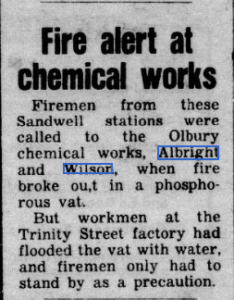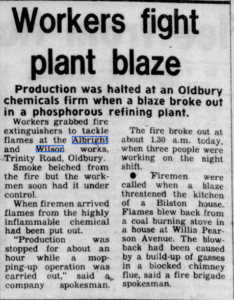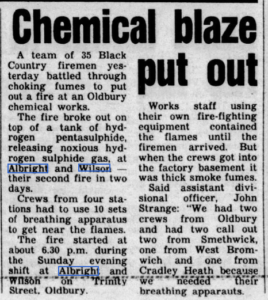
Or Pratt Day’s year off
The context of Albright and Wilson’s cheapskate cost-cutting, see last post, is revealed in the Hugh Podger Book “The last 50 years”.
The Thatcher Government began to privatise industries and the economic recession bit hard.
“During this period the price of oil, which averaged $13 per barrel in 1978 , rose to $19 in 1979 and $32 in 1980, peaking at an average of $36 in 1981.
“The impact of the recession at Albright and Wilson was felt from mid-1980 , alongside the impact of higher oil prices which affected trade around the world.”
This should not be taken as an excuse to the costs at Trinity Street being cut , when this company had nearly gone bust in the 1970’s due to abysmal management decisions such as the Long Harbour pollution scandal, and were bailed out by American firm Tenneco in 1978. In 1981, Podger claims that AW made £503 Million in sales, so they were hardly as piss poor as some companies that went under during the early days of the Iron Lady.
At this point in time the works manager was called Pat Day, who would have been ultimately responsible for all that went on in the works- including all the cost-cutting and health and safety corner cutting going on. From what we saw from the last post of the thousands of pounds claimed to be being saved by his foremen lieutenants, there is no doubt to anyone of sound mind that there was a direct correlation between consequent “accidents” , leaks, spillages and fires. And these are only the reported ones. When it is further learnt in the 1997 audit of this factory by the newly created Environment Agency that managers bonuses were linked to environmental performance, you can see that reporting such would put managers at considerable disadvantage. An example was cited in this later report of a chlorine leak at the factory which was a notifiable release.
The 6th March 1981 Sandwell Evening Mail kicks off a round of misfortunes at phosphorus towers. The article states that a “phosphor vat” had filled a process unit with dense smoke. I take this to be white phosphorus, and the “dense smoke” phosphorus pentoxide exposed to air. Day is quoted in the piece with suitable lamentable excuse.
A couple of weeks later, the 24th March Mail reported another Trinity Street fire on Day’s watch, in the same fucking plant! What warnings were given out to the community were probably none existent , and the air raid siren would be unlikely to have been sounded. Water is also not the recommended method of tackling a phosphorus fire, FFS!
In May, on 23rd, the same paper reported another fire, in the named “phosphorus refining plant” had broken out. I’m not sure if this is the same place as the previous two, but it shows that they obviously had a major failure of systems in this unit at this time, and inadequate foremen managing the operation.
The fire broke out at night when three people were on duty. As for the “mopping up” operation, we all know to where the dross of this incident would have been taken- in drums to rattlechain lagoon and dumped there.
I had to look twice at the next article to make sure that it wasn’t the same fire, but it isn’t. Just two days later, another fire befell the works. This time firefighters were directly involved in fighting the serious chemical incident and had to use breathing apparatus to extinguish the flames in the pentasulphide plant. Hydrogen sulphide gas was evolved, and there is no doubt that this was a direct risk to offsite receptors even if those at Trinity Street would try to suggest otherwise.
At what point the fire service were involved at least politely in saying “what the fuck are you doing here?” is unknown, but surely by now the local community were beginning to see the cuts biting. A theme appears to emerge of night shifts and low staffing when these incidents were occurring- all involving fire crew call outs from numerous local stations, putting other members of the public at risk.
999 was again the number dialled on 22nd October, and again the SEM reported the news that another chlorine leak had occurred. There had been another leak of this chemical of course in 1974 where several staff had required hospital treatment.
And so to the 30th November Evening Mail and yet another works fire. This would be a laboratory one and to say that “safety experts” were investigating this in reference to Albright and Wilson’s own useless staff is like The Pope looking into the dealings of a johnny factory.
Again we see the blame on technology, and yet the weekend had seen nobody present to monitor what was occurring- another clear indication of staff not being around and a cost- cut in doing so. In this same month the phosphine NO1 factory at this site was commissioned, and that too would end up as a total fiasco.
I would say that every experiment that this company did went wrong- the most obvious one being cutting corners in health and safety matters, and employing idiot managers who could not manage the piss in their own catheter bags.
PLEASE, GIVE UP THE JOB, DAY!







